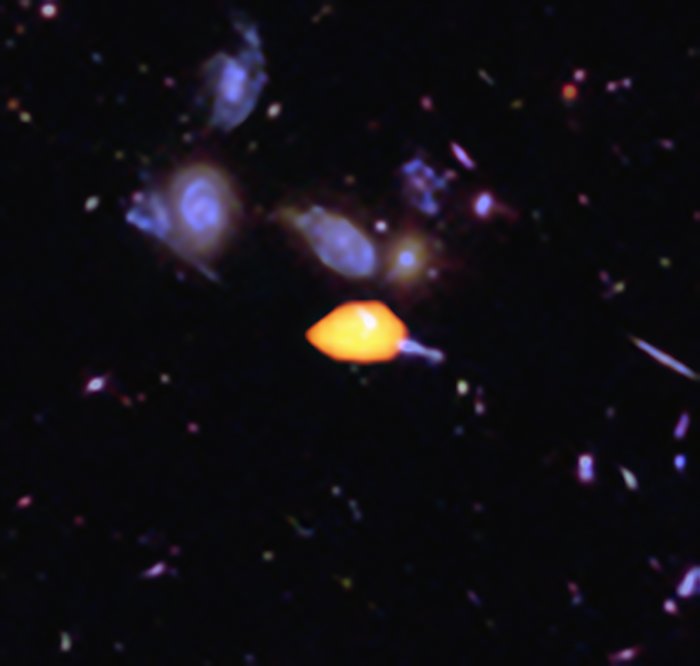ALMA deep view of part of the Hubble Ultra Deep Field
The Atacama Large Millimeter/submillimeter Array (ALMA) surveyed the Hubble Ultra Deep Field, uncovering new details of the star-forming history of the Universe. This close-up image reveals one such galaxy (orange), rich in carbon monoxide, showing it is primed for star formation. The blue features are galaxies imaged by Hubble.
This image is based on the very deep ALMA survey by Manuel Aravena, Fabian Walter and colleagues, covering about one sixth of the full Hubble Ultra Deep Field area.
Links:
- ESO Press release
- ALMA probes the Hubble Ultra Deep Field
- ALMA probes the Hubble Ultra Deep Field
- ALMA deep view of part of the Hubble Ultra Deep Field
B. Saxton (NRAO/AUI/NSF); ALMA (ESO/NAOJ/NRAO); NASA/ESA Hubble
About the Image
NASA press release
| Id: | eso1633d |
| Type: | Observation |
| Release date: | 23 September 2016, 16:36 |
| Size: | 1345 x 1279 px |
About the Object
| Name: | Hubble Ultra Deep Field |
| Type: | Early Universe : Cosmology : Morphology : Deep Field |
| Constellation: | Fornax |
| Category: | Cosmology |
Wallpapers
Coordinates
| Position (RA): | 3 32 38.59 |
| Position (Dec): | -27° 46' 34.68" |
| Field of view: | 0.39 x 0.37 arcminutes |
| Orientation: | North is 0.0° left of vertical |
Colours & filters
| Band | Wavelength | Telescope |
|---|---|---|
| Optical B | 435 nm |
Hubble Space Telescope
ACS |
| Optical V | 606 nm |
Hubble Space Telescope
ACS |
| Optical i | 775 nm |
Hubble Space Telescope
ACS |
| Optical I | 850 nm |
Hubble Space Telescope
ACS |
| Optical I | 814 nm |
Hubble Space Telescope
ACS |
| Infrared Z | 1.05 μm |
Hubble Space Telescope
WFC3 |
| Infrared J | 1.25 μm |
Hubble Space Telescope
WFC3 |
| Infrared H | 1.6 μm |
Hubble Space Telescope
WFC3 |
| Millimeter 231.2 GHz | 1.3 mm | Atacama Large Millimeter/submillimeter Array |


